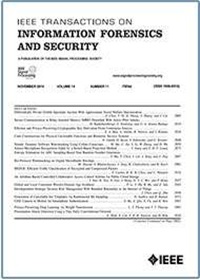Secrecy Coding for the Binary Symmetric Wiretap Channel via Linear Programming
IF 6.3
1区 计算机科学
Q1 COMPUTER SCIENCE, THEORY & METHODS
IEEE Transactions on Information Forensics and Security
Pub Date : 2025-02-25
DOI:10.1109/TIFS.2025.3545301
引用次数: 0
Abstract
In this paper, we use a linear programming (LP) optimization approach to evaluate the equivocation when coding over a wiretap channel model where the main channel is noiseless and the eavesdropper’s channel is a binary symmetric channel (BSC). Using this technique, we present a numerically-derived upper bound for the achievable secrecy rate in the finite blocklength regime that is tighter than traditional infinite blocklength bounds. We also propose a secrecy coding technique that outperforms random binning codes. When there is one overhead bit, this coding technique is optimum and achieves the newly derived bound. For cases with additional bits of overhead, our coding scheme can achieve equivocation rates close to the new bound. Furthermore, we explore the patterns of the generator matrix and the parity-check matrix for linear codes and we present binning techniques for both linear and nonlinear codes using two different approaches: recursive and non-recursive. To our knowledge, this is the first optimization solution for secrecy coding obtained through linear programming. Our new bounds and codes mark a significant breakthrough towards understanding fundamental limits of performance (and how to achieve them in some instances) for the binary symmetric wiretap channel with real finite blocklength coding constructions. Our techniques are especially useful for codes of small to medium blocklength, such as those that may be required by applications with small payloads, such as the Internet of Things.求助全文
约1分钟内获得全文
求助全文
来源期刊

IEEE Transactions on Information Forensics and Security
工程技术-工程:电子与电气
CiteScore
14.40
自引率
7.40%
发文量
234
审稿时长
6.5 months
期刊介绍:
The IEEE Transactions on Information Forensics and Security covers the sciences, technologies, and applications relating to information forensics, information security, biometrics, surveillance and systems applications that incorporate these features
 求助内容:
求助内容: 应助结果提醒方式:
应助结果提醒方式:


